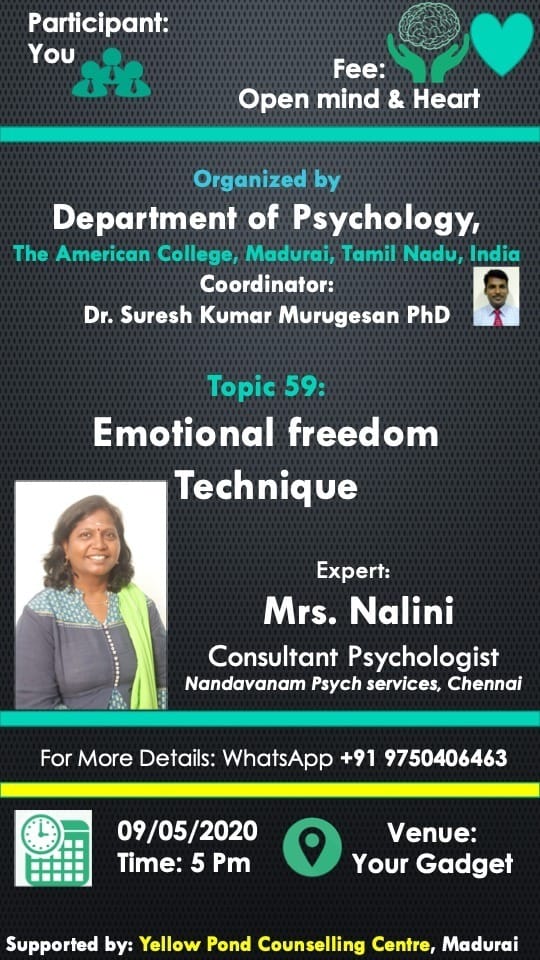Emotional Freedom Technique of Mrs. Nalini
Lee Justin Rondina

The Emotional Freedom Technique or EFT is a psychological healing method that can be used during counselling interventions. It aims to reduce or relieve pain and stress and to cope up with anxieties, depression, fears and/or phobias. It can also be used when dealing with specific issus like eating disorders, weight loss and management, sleeping disorders, post traumatic stress disorders, addictions, and cravings. Basically it involves treatment of any negative issues on emotions, feelings, and thoughts.
The EFT is founded on the idea that there are supposed meridians or energy line spots in which energy flows through to maintain balance of health. But when a distressing event occur, it causes me disruption or blockage on these meridians thus resulting into negative emotions that we feel (e.g. pain, sadness, anger, etc.). Thus, the EFT is performed by gently tapping on these disrupted meridians to clear the block and direct the energy, therefore relieving one’s self of the negativities.
This technique was developed by Gary Craig in the 1990’s and was heavily based on the ancient Chinese acupuncture and acupressure methods. However, the EFT does not incorporate the use of needles and is rather drawn from various currently existing psychotherapies such as Cognitive Behavioral Therapy, Exposure Therapy, and a lot more on Roger Callahan’s Thought Field Therapy. It should be emphasized that the EFT is not necessarily a direct remedy to ailments especially with psychotic disorders and does not encourage halting any supposed medicinal intake of a patient. The patient is still recommended to intake medicine (if there are any), and may be done along with the EFT.
Currently, there is a simplified EFT tapping protocol or the Basic Recipe devloped by Craig which involves several main tapping points such as the eyebrow, side of the eye/temple, under eye, under nose, chin, collar bone, under arm, thumb, index finger, middle finger, ring finger, little finger, and the karate chop (the edge of the hand that makes contact when doing a karate chop). There is also the crown point and the 9 gamut point (about an inch below the knuckles between the bases of the ring and little fingers) usually involved in the 9 gamut procedure.
The Basic Recipe starts with the patient stating his/her problem and measure the intensity of the issue in a scale of 1-10. Next, the patient performs the “setup” by gently tapping the karate chop point continuously and speaks a designative phrase that involves acknowledging the main issue and accepting yourself in spite of it. A series of exchange are then done between the therapist and patient whilst still performing the setup.
The patient then proceeds to the tapping sequence by tapping the main points while continuously speaking phrases regarding the issue at each specific point. Next, the patient performs the 9 gamut procedure, a series of nine steps that involves body and eye movements, humming a song, and tapping the 9 gamut point. The patient would then do the tapping sequence again, and afterward, he/she will now measure the current intensity of the issue and see if there is any change from the previous measurement. The patient would repeat all the mentioned steps again if necessary or until a 0 measurement is achieved.
Other techniques that incorporate the same concept of the EFT may also be used such as storytelling, movie therapy, the TREE metaphor, and the Matrix Reimprinting Technique. The EFT as a theraphy is said to work well especially with children or the inner child within ourselves. It is considered to be clinically effective with PSTD clearing up to 80% of PTSD symptoms after 6 sessions. It can be used for a quick anxiety stopper, a quick relaxation, and to have personal peace with our negative memories and feelings.
stop admitting a patient. The patient is also advised to take medication (if any) and this can be done along with the EFT.
There is currently a simplified EFT tapping protocol or The Basic Recipe developed by Craig which includes several main tapping points such as eyebrows, side of eye/temples, under eye, under nose, chin, collarbone, under arm, thumb, index finger, middle finger, ring finger , pinky, and the karate chop (the edge of the hand that makes contact during karate chop). There is also the crown point and the 9 gamut point (about an inch below the knuckles between the base of the ring and the little fingers) which are usually involved in the 9 gamut procedure.
The Basic Recipe begins with the patient identifying their problem and measuring the intensity of the problem on a scale of 1 to 10. Next, the patient performs the “setup” by continuously tapping the karate chop point gently and speaks a defining phrase, acknowledging the main issue while still accepting oneself. A series of exchanges between the therapist and the patient are then carried out while the setup is still being carried out.
The patient then continues the tapping sequence by tapping on the main points while continuously speaking sentences related to the problem at each particular point. Next, the patient performs the 9-Gamut procedure, a series of nine steps that includes body and eye movements, humming a song, and tapping the 9-Gamut point. The patient would then perform the tapping sequence again and then measure the current intensity of the problem and see if there are any changes from the previous measurement. The patient would repeat all of the above steps again as needed or until a 0 reading is achieved.
Other techniques that incorporate the same concept of EFT can also be used such as: B. Storytelling, film therapy, the TREE metaphor and the matrix reimprinting technique. EFT as a therapy is said to work particularly well with children or the inner child in us. It is considered clinically effective if PSTD eliminates up to 80% of PTSD symptoms after 6 sessions. It can be used for a quick anxiety stop, quick relaxation and to have personal peace with our negative memories and feelings.
